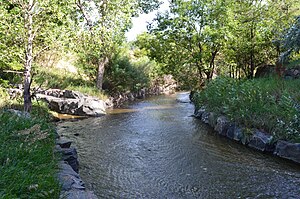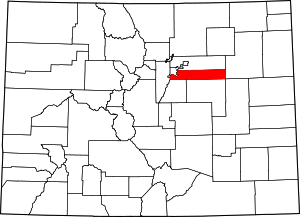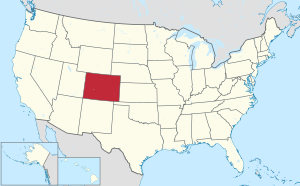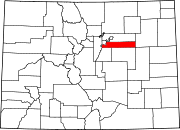|
Arapahoe County, Colorado
Arapahoe County (/əˈræpəhoʊ/ ə-RAP-ə-hoh) is a county located in the U.S. state of Colorado. As of the 2020 census, its population was 655,070,[1] making it the third-most populous county in Colorado. The county seat is Littleton,[3] and the most populous city is Aurora. The county was named for the Arapaho Native American tribe, who once lived in the region.[2] Arapahoe County is part of the Denver-Aurora-Lakewood metropolitan statistical area. Arapahoe County calls itself "Colorado's First County", since its origins antedate the Pike's Peak Gold Rush. HistoryOn August 25, 1855, the Kansas Territorial Legislature created a huge Arapahoe County to govern the entire western portion of the Territory of Kansas. The county was named for the Arapaho Nation, who lived in the region.[2] In July 1858, gold was discovered along the South Platte River in Arapahoe County (in present-day Englewood). This discovery precipitated the Pike's Peak Gold Rush. Many residents of the mining region felt disconnected from the remote territorial governments of Kansas and Nebraska, so they voted to form their own Territory of Jefferson on October 24, 1859. The following month, the Jefferson Territorial Legislature organized 12 counties for the new territory, including a smaller Arapahoe County. Denver City served as the county seat of Arapahoe County. The Jefferson Territory never received federal sanction, and when the State of Kansas was admitted to the Union on January 29, 1861, the mining regions temporarily reverted to unorganized territory. On February 28, 1861, Congress passed an act organizing the Territory of Colorado, using present-day borders.[4] On November 1, 1861, the Colorado Territorial Assembly organized the 17 original counties of Colorado, including a new Arapahoe County. Arapahoe County originally stretched from the line of present-day Sheridan Boulevard 160 miles (260 km) east to the Kansas border, and from the line of present-day County Line Road 30 miles (48 km) north to the 40th parallel north (168th Avenue). Denver City served as the county seat of Arapahoe County until 1902. In 1901, the Colorado General Assembly voted to split Arapahoe County into three parts - a new consolidated City and County of Denver, a new Adams County, and the remainder of the Arapahoe County to be renamed South Arapahoe County. A ruling by the Colorado Supreme Court, subsequent legislation, and a referendum delayed the reorganization until November 15, 1902. Governor James Bradley Orman designated Littleton as the temporary county seat of South Arapahoe County. On April 11, 1903, the Colorado General Assembly changed the name of South Arapahoe County back to Arapahoe County. On November 8, 1904, Arapahoe County voters chose Littleton over Englewood by a vote of 1310 to 829 to be the permanent county seat. Geography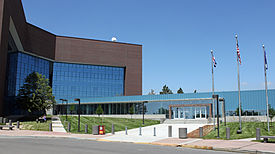 According to the U.S. Census Bureau, the county has a total area of 805 square miles (2,080 km2), of which 798 square miles (2,070 km2) are land and 7.3 square miles (19 km2) (0.9%) are covered by water.[5] The county measures 72 mi (116 km) east-west and 4 to 12 mi (6.4 to 19.3 km) north-south. Two exclaves of Arapahoe County are entirely surrounded by the City and County of Denver, the City of Glendale, and the Holly Hills neighborhood, a census-designated place. Adjacent counties
Major highways
State parkHistoric trailsRecreation trailsDemographics
As of the census of 2000, 487,967 people, 190,909 households, and 125,809 families were residing in the county. The population density was 608 people/sq mi (235 people/km2). The 196,835 housing units averaged 245 per square mile (95/km2). The racial makeup of the county was 79.93% White, 7.67% African American, 0.66% Native American, 3.95% Asian, 0.12% Pacific Islander, 4.51% from other races, and 3.16% from two or more races. Hispanics or Latinos of any race made up 11.81% of the population. Of the 190,909 households, 34.90% had children under the age of 18 living with them, 51.20% were married couples living together, 10.60% had a female householder with no husband present, and 34.10% were not families. About 27.00% of all households were made up of individuals, and 5.90% had someone living alone who was 65 years of age or older. The average household size was 2.53, and the average family size was 3.11. In the county, the age distribution was 26.70% under 18, 8.60% from 18 to 24, 33.10% from 25 to 44, 23.00% from 45 to 64, and 8.60% who were 65 or older. The median age was 34 years. For every 100 females, there were 97.10 males. For every 100 females age 18 and over, there were 94.20 males. The median income for a household was $53,570, and for a family was $63,875. Males had a median income of $41,601 versus $31,612 for females. The per capita income for the county was $28,147. About 4.20% of families and 5.80% of the population were below the poverty line, including 7.00% of those under age 18 and 5.10% of those age 65 or over. EducationK-12 EducationArapahoe County is home to nine public school districts: Aurora, Bennett, Byers, Cherry Creek, Deer Trail, Englewood, Littleton, Sheridan, and Strasburg.[11] In the 2023-2024 school year, Cherry Creek and Littleton were ranked the #5 and #6 school districts in Colorado, by Niche.com respectively.[12] In addition, Cherry Creek High School in Greenwood Village was ranked the #2 public high school in Colorado, while Grandview High School in Aurora was ranked #6.[13] There are also several private schools throughout the county, including St. Mary's Academy in Cherry Hills Village, Regis Jesuit High School in Aurora, and Kent Denver School in Englewood, the latter of which was ranked Colorado's #1 high school.[14] Higher EducationArapahoe County is home to two large community colleges: Arapahoe Community College in Littleton, and the Community College of Aurora. The county is also home to the University of Colorado Anschutz Medical Campus and the Denver South campus of Colorado Technical University, both located in Aurora. PoliticsArapahoe County was once extremely conservative. In the 1924 Colorado gubernatorial election, Republican Clarence Morley, who was openly affiliated with the Ku Klux Klan, won over 66% of the vote in Arapahoe County, a higher percentage than he received in any other county in Colorado.[15] In addition, the county for many years was represented in congress by Republican Tom Tancredo, a hardcore conservative known for his controversial anti-immigration, anti-Catholic, and nativist political beliefs.[16][17] As the Denver Metro Area grew in the 1960s and beyond, Arapahoe County became a classic bastion of suburban conservatism throughout the 1980s. However, heavy urbanization, demographic changes and population increases - such as the rapid diversification of Aurora's population and younger professionals in the southern suburbs - have caused the county to become much more competitive since the 1990s, eventually changing it to more of a Democratic-leaning suburban swing county. In 2008, the county swung over dramatically to support Barack Obama, who became the first Democrat to carry it since 1964, and only the second since 1936. It swung from a four-point win for George W. Bush in 2004 to a 13-point win for Obama in 2008. It voted for Obama by a similar margin in 2012, and provided much of Hillary Clinton's statewide margin in 2016 as Donald Trump failed to win even 40 percent of the vote in one of the worst showings for a Republican in the county's history, with the Democrats carrying the former Tech Center area Republican strongholds of Centennial and Littleton. In the 2020 election, Joe Biden became the first Democrat to carry the county with over 60% of the vote since 1916, winning both Aurora by lopsided margins and the southern parts of the county by nearly 20 points.[18][19]
CommunitiesCities
Towns
Census-designated places
Former census-designated places
See also
References
External links |
||||||||||||||||||||||||||||||||||||||||||||||||||||||||||||||||||||||||||||||||||||||||||||||||||||||||||||||||||||||||||||||||||||||||||||||||||||||||||||||||||||||||||||||||||||||||||||||||||||||||||||||||||||||||||||||||||||||||||||||||||||||||||||||||||||||||||||||||||||||||||||||||||||||||||||||||||||||||||||||||||||||||||||||||||||||||||||||||||||||||||||||||||||||||||||||||||||||||||||
